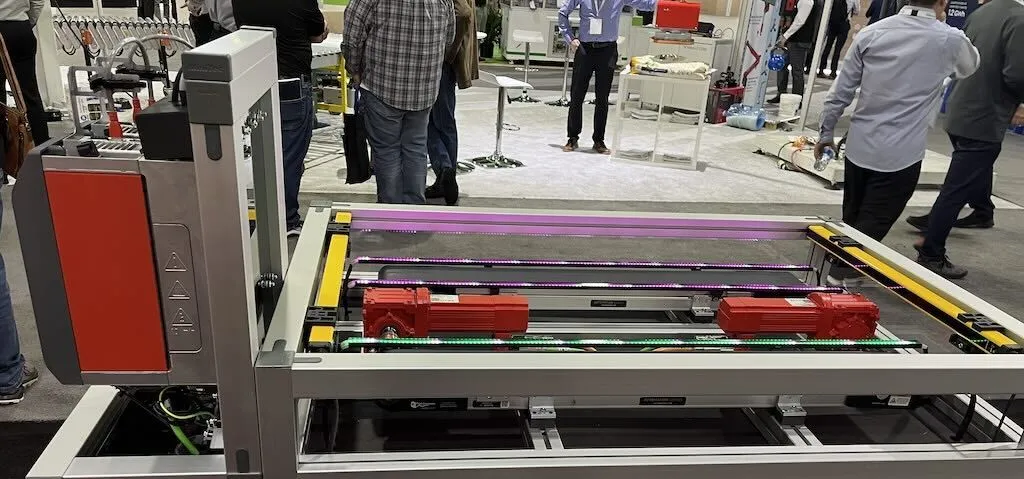
By Chris Vavra March 22, 2024
Collected at: https://www.plantengineering.com/articles/modex-2024-recap-making-logistics-supply-chain-management-safer-and-smarter/
Modex 2024 in Atlanta offered many insights and advances in the world of material handling and logistics. A key theme throughout was the need to keep workers safe while also improving material handling operations through advances in automation, robotics, digital technologies and more. Injured or ineffective workers in a fast-paced facility can have just as profound an effect on downtime and worker morale, if not moreso.
Manufacturers and suppliers realized the importance of this theme and were displaying technology solutions that were effective and kept workers safe while straddling the line and keeping operations efficient.
At the SEW Eurodrive booth, for example, they showed synchronous motion and safety using their MOVI-C automation platform, which combines software, controls and components to move products safely while working alongside people.
Another added feature is because the product is designed to work alongside humans, it also slows down if people get too close to the sensors or to certain aspects of the line. The operations don’t stop, though. Workers remain safe while the production line continues running and avoiding downtime.
Jeremy McCullough, senior product and application engineer for SEW Eurodrive, said, “The interesting thing about safety is it doesn’t have to be complicated. It can be easy. What we try to emphasize is helping users pick the right product and apply it in the right way.”

SEW Eurodrive’s MOVI-C automation platform, which combines software, controls and components to move products safely while working alongside people. Courtesy: Chris Vavra, CFE Media and Technology
Improving accuracy and efficiency
Aaron Woytcke, director of marketing for SICK, also explained how they were emphasizing safety while still being productive.
He said, “Historically, safety stops all motion, but is no longer the case. You want to keep things moving to maintain throughput, and also make sure personnel are safe.”
Woytcke emphasized how they’re trying to make the tracking process faster and more automated using sensors and machine vision to automate the assembly line and put it less in the hands of people and having a seamless transition from one end to the other. Having sensors and cameras that can reliably scan and provide good data to the users is critical.
“The data is there and you learn from it,” he said. “You improve your preventive maintenance and keep workers safety and improve your process reliability.”
Brad Thomas, director of market product management for SICK Sensor Intelligence, showed a demo designed to reduce and one day eliminate missorts, which is a common challenge companies face on a production line.

SICK’s demo is working on reducing and eliminating missorts, which is a common challenge companies face on a production line. Courtesy: Chris Vavra, CFE Media and Technology
“When you get the wrong package,” he said, “it’s because it went somewhere it shouldn’t, but you don’t know why. We’re high on data accuracy.”
In a fast-paced environment, the barcode scanner might make a mistake due to a package going in the right direction or place because objects move around. The barcode scanner might pick up the barcode or it might not, depending. SICK demonstrated scanners that could pick up the information and relay it to the software.
No process is perfect, but Thomas said they can learn from past incidents and find patterns.
“Depending on the process, you can address the problem and do some isolated maintenance. You look at the data and determine history.”
Making automation simpler and safer
The presentations at Modex also emphasized how automation had changed and is being accelerated by a growth in efficiency and profitability.
Christoph Buchmann, sales director of Movu Robotics, said, “20 years ago automation was big and complex. That has changed. It’s become scalable, affordable, accessible and less complicated,” in his presentation “Mastering the Path to Automation: A Roadmap for Successful Implementation.”
He added successful automation is not as simple as pushing a button, there is a greater degree of freedom because technologies such as automated guided vehicles (AGVs) and autonomous mobile robots (AMRs) are making it possible for companies to have more freedom in how they choose to resolve a problem. Flexibility is key.
Mark Walters, industry segment sales manager at Festo, said they’ve been moving from pneumatics to an electrified and automated process to give customers more flexibility on the production line as well as lowering the total cost of ownership (TCO).

Festo is trying to give customers more flexibility on the production line as well as lowering the total cost of ownership by emphasizing mechatronics, electrification and automation. Courtesy: Chris Vavra, CFE Media and Technology
“The focus is to be more mechatronic,” he said. “We look at a system and address the problem based on situation and need.”
The factory of the future will be different and definitely more automated than before. It also will be more flexible, giving machines and humans the freedom of action needed to do their jobs.

Leave a Reply